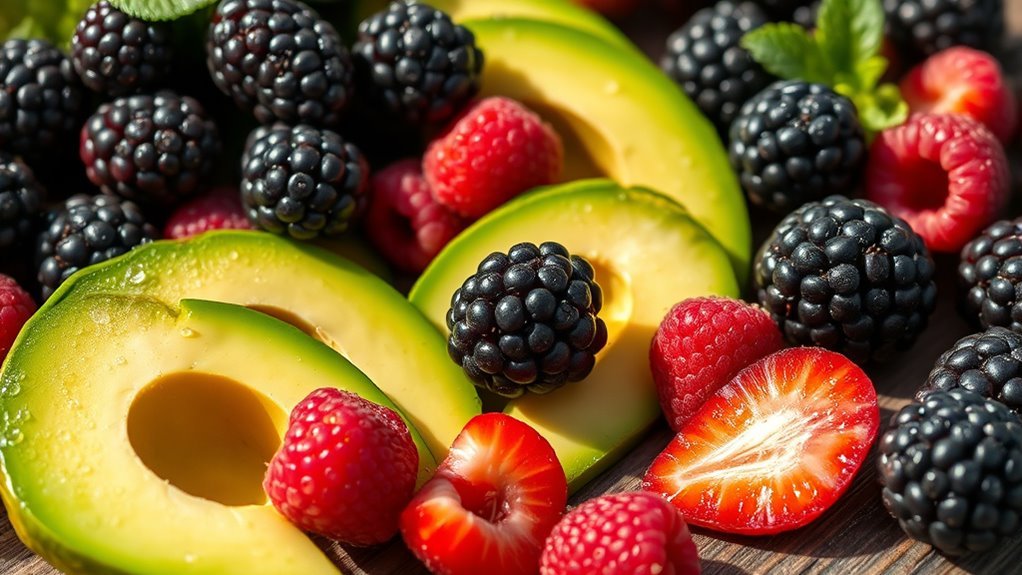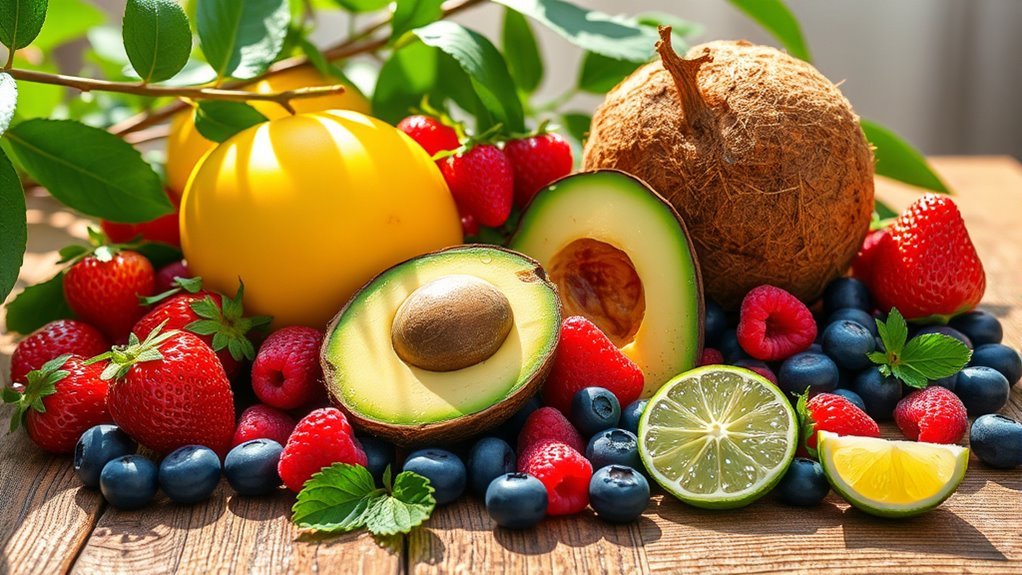Yes, you can enjoy fruit on a keto diet, but stick to low-carb options. Fruits like berries and avocados are great choices, while high-carb fruits such as bananas and grapes should be avoided. Focus on portion sizes and monitor your intake to stay within daily carb limits. These low-carb fruits can provide essential nutrients without derailing your keto goals. Explore further to find creative ways to incorporate fruits into your meals and snacks.
Understanding the Keto Diet and Its Guidelines

When you’re considering the keto diet, it’s essential to understand its fundamental principles, as they guide your food choices and overall approach. The keto basics revolve around drastically reducing carbohydrate intake while increasing fats, which shifts your body into a state of ketosis. In this state, your body burns fat for fuel instead of carbs. A typical guideline suggests that about 70-75% of your daily calories should come from fats, 20-25% from protein, and only 5-10% from carbohydrates. This means prioritizing low-carb foods like meats, dairy, and non-starchy vegetables. Understanding these diet principles not only helps you make informed decisions but also empowers you to enjoy the freedom of eating within the ketogenic framework while achieving your health goals.
The Carb Count of Common Fruits

How do you navigate the world of fruits while sticking to a keto diet? Understanding the carb count of common fruits can help you make informed choices and enjoy your meals without compromising your goals. Here’s a quick breakdown of the fruit carb content you should consider:
- Avocado: About 2 grams of net carbs per serving, making it a fantastic keto-friendly option.
- Berries: Raspberries and blackberries have around 6-8 grams of net carbs per cup, allowing for moderate servings.
- Melons: Watermelon and cantaloupe contain roughly 11-12 grams of net carbs per cup, so keep portions in check.
Keto-Friendly Fruits You Can Enjoy

While traversing a keto diet, you might wonder which fruits can fit into your meal plan without derailing your carb intake. Fortunately, there are several keto-friendly fruits to enjoy. Berries like strawberries, raspberries, and blackberries are low in carbs and high in fiber, making them perfect for your keto fruit smoothies. Avocados, often overlooked, are also a fantastic choice, packed with healthy fats. You can even indulge in small portions of melons, like cantaloupe and watermelon. These fruits can make delightful additions to low carb desserts, allowing you to satisfy your sweet tooth while staying on track. Embracing these options can help you maintain your freedom in food choices while following a keto lifestyle.
Fruits to Avoid on a Keto Diet
On a keto diet, it’s essential to be mindful of certain fruits that can derail your carb goals. High-carb fruits like bananas and grapes can quickly add up in carbohydrates, while dried fruits often contain concentrated sugars. Additionally, fruit juices may seem healthy but can be packed with sugars, making them a risky choice for maintaining ketosis.
High-Carb Fruits
When starting a keto diet, it’s essential to be aware of high-carb fruits that can easily derail your progress. While fruits can be delicious, certain high sugar fruits should be avoided to maintain ketosis. Here are three fruits to watch out for:
- Bananas – Packed with carbs, a single banana can exceed your daily carb limit.
- Grapes – These juicy treats contain high sugar content, making them a poor choice for keto.
- Mangoes – While tasty, mangoes are dense in carbs and can quickly impact your ketosis.
If you want to include fruits, consider careful fruit portioning with low-carb options. Stay informed, and you can enjoy your keto journey without compromising your goals!
Dried Fruits Warning
Although many people enjoy the convenience and taste of dried fruits, they can pose a significant challenge for those following a keto diet. Dried fruit types, like raisins, dates, and apricots, often have concentrated sugar content due to the removal of water. This process intensifies the natural sugars, making them high in carbohydrates. For example, just a small serving of raisins can contain over 30 grams of carbs, which is usually more than what you’d want in a day on keto. If you’re aiming for a low-carb lifestyle, it’s best to avoid these sugary snacks. Instead, consider fresh, low-carb options like berries, which can offer satisfying sweetness without derailing your keto goals.
Fruit Juices Caution
While many people think of fruit juices as a healthy beverage choice, they can be surprisingly high in sugars and carbohydrates, making them problematic for those on a keto diet. To maintain your freedom in choosing what to drink, it’s essential to understand which juice types to avoid. Here are three common offenders:
- Orange Juice: One serving (8 oz) can pack over 25 grams of carbs.
- Apple Juice: Just 8 oz contains around 28 grams of sugars.
- Grape Juice: This juice type can have about 36 grams of carbs per serving.
Always check serving sizes and nutritional content to make informed choices. Opt for low-carb alternatives to stay within your keto goals while enjoying your beverages.
How to Incorporate Fruits Into Your Keto Meals
Incorporating fruits into your keto meals can be a delightful way to enhance flavor and add essential nutrients, as long as you choose the right types and portion sizes. Focus on low-carb fruits like berries, avocados, and olives, and consider strategic fruit pairings to optimize your meals.
| Fruit | Best Pairing | Ideal Meal Timing |
|---|---|---|
| Raspberries | Greek yogurt | Breakfast or snack |
| Avocado | Eggs | Brunch or lunch |
| Blackberries | Nut butter | Afternoon snack |
| Olives | Cheese | Appetizer or salad |
Benefits of Eating Low-Carb Fruits
Eating low-carb fruits can offer you significant nutrient density, providing essential vitamins and minerals without overwhelming your carb intake. These fruits also boast antioxidant properties, which can help combat oxidative stress in your body. Additionally, they may support blood sugar regulation, making them a smart choice for those following a keto lifestyle.
Nutrient Density Benefits
When you think about low-carb fruits, it’s easy to overlook their impressive nutrient density. These fruits not only fit your keto lifestyle but also provide essential vitamins and minerals that enhance nutrient absorption. Here are three key benefits of incorporating low-carb fruits into your diet:
- Vitamin Richness: Many low-carb fruits, like berries, are packed with vitamins C and K, essential for overall health.
- Mineral Boost: They offer important minerals such as potassium and magnesium, which can help maintain electrolyte balance.
- Fruit Variety: A diverse selection of low-carb fruits adds flavor and texture, making your meals more enjoyable while supporting your nutritional needs.
Embracing low-carb fruits can help you maintain a balanced diet while enjoying the freedom of delicious flavors.
Antioxidant Properties
While many people associate fruits with high sugar content, low-carb fruits offer a wealth of antioxidants that can greatly benefit your health. These fruits, like berries, avocados, and tomatoes, provide powerful antioxidant properties that combat oxidative stress and inflammation. By incorporating various low-carb fruit varieties into your diet, you can enjoy the antioxidant benefits without the sugar highs that come with traditional fruits. Antioxidants play a vital role in supporting your immune system and reducing the risk of chronic diseases. So, don’t shy away from these low-carb options; they not only satisfy your cravings but also enhance your overall well-being. Embracing these fruits allows you to maintain your health goals while enjoying the natural goodness they offer.
Blood Sugar Regulation
Incorporating low-carb fruits into your diet can greatly aid in blood sugar regulation, especially for those following a ketogenic lifestyle. These fruits can help minimize blood sugar spikes and promote a balanced insulin response. Here are three benefits to evaluate:
- Lower Glycemic Index: Low-carb fruits typically have a lower glycemic index, reducing the likelihood of rapid blood sugar spikes.
- Fiber Content: Many of these fruits are rich in fiber, which slows digestion and helps stabilize blood sugar levels.
- Nutrient Density: They provide essential vitamins and antioxidants without the excess carbohydrates, supporting overall health.
Creative Ways to Use Fruits in Keto Recipes
Although the keto diet typically limits high-carb fruits, there are creative ways to incorporate lower-carb options that can enhance your meals. For instance, whip up invigorating fruit smoothies using berries as a base. You can also create vibrant fruit salads while keeping carbs in check. Consider using fruits as dessert toppings on keto-friendly treats or mixing them into breakfast bowls for a nutritious start. Try adding fruit salsas to savory dishes for an exciting flavor twist. Additionally, fruits can serve as delicious keto snacks or be infused into water for a revitalizing drink. Finally, don’t forget to experiment with fruits in baking ingredients or pair them with cheese for a satisfying combination. Enjoy the freedom to be creative!
Monitoring Your Carb Intake With Fruits
When following a keto diet, it’s important to keep a close eye on your carb intake, especially when it comes to fruits. Many fruits can be higher in carbs than you might think, so monitoring your fruit portions is vital. Here are three effective tips for carb tracking:
- Choose Low-Carb Fruits: Opt for berries, avocados, and melons, which typically have fewer carbs than other fruits.
- Use a Food Diary: Keep track of your fruit intake, noting portion sizes and carb counts to stay within your daily limits.
- Check Labels: When buying packaged fruit products, always read nutritional labels for hidden sugars and total carbohydrates.


